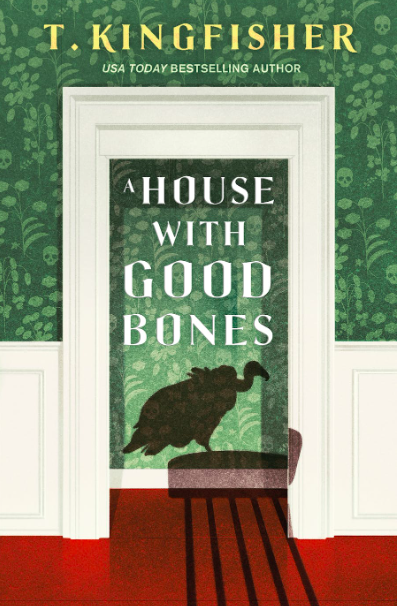
A House with Good Bones (2023) by T. Kingfisher takes a light approach to some heavy questions: Can you escape generational abuse? Can you repudiate the racism of your ancestors without rejecting their entire legacy? Can you stop a ghost from bullying your mom? The result is an uneven mix of interesting themes and undeveloped characters.
An archaeoentomologist, Samantha “Sam” Montgomery is obsessed with insects and studies them at historical digs. When she is furloughed from a job in the Pacific Northwest, she decides to stay in North Carolina with her mother, Edith. But things are not right on Lammergeier Lane. The house is surrounded by vultures and her mother, who has lost a considerable amount of weight, is riddled with anxiety. Never one for religion, her mom now prays over dinner and refrains from cursing even in crazy situations where only an F-bomb will do. Most disturbing of all, she has painted the colorful walls of the house a sterile white and replaced the fun fish art with a Confederate wedding portrait. Bland colors and racist decor were, Sam remembers, part and parcel of her late grandmother’s style. Now her mom acts like “Gran Mae” is back and, if the irrepressible health of the dead woman’s rose garden is any indication, then her force is strong. But Sam doesn’t believe in ghosts; she’s an archaeoentomoligist, remember? As she focuses on rational explanations for her mother’s strange behavior–grief, depression, dementia, etc.–Sam stumbles upon her family’s history of wizardry and dark magic. Can she confront her inheritance and save her mom?
Kingfisher expertly explores themes of body image, emotional abuse, and racism. An increasing number of women are writing horror, and their perspectives give us more nuanced female characters. Still, I’ve never encountered a protagonist as realistically embodied as Sam. She tells you how it feels to navigate the world as a large woman: Family members fat-shame her; doctors misdiagnose her; and neighbors assume she’s incapable of committing crimes that require agility and grace (like cat burglary). Depending on the situation, Sam’s weight makes her invisible or awkwardly obvious, and she can never forget her physicality because it’s always an issue for other people. We cannot transcend our bodies to tell a story (nor should we want to), and Kingfisher reminds us of this truth.
I also appreciate the parallel Kingfisher draws between paranormal haunting and emotional abuse. Edith knows that her mother’s spirit has returned because the house is filled with old tensions and resentments: The atmosphere is heavy, almost electric and the storm of her mother’s anger will, she knows, eventually break in violence. It’s humiliating that, as an adult, she’s forced to relive the helplessness of her childhood. The brief but intense descriptions of Edith’s troubled youth are sad but artistically necessary notes in an otherwise funny book; it reminds you of what’s at stake.
The novel is also refreshingly honest about the uncomfortable fact that, if you are white, your grandparents are probably racist. Sam openly recognizes Gran Mae for the bigot she was, neither smoothing her edges nor dismissing her views as simply “quaint.” Rather than safely relegating racist ideologies to a dead past, she is keenly aware of their resurgence in the present. For instance, when Sam learns that Edith has forbidden Maria, her hispanic daughter-in-law, from visiting, she wonders if her mom is being targeted by a white nationalist group. She’s also self-reflexive, cognizant of her own biases and blind spots.
While there’s much to admire in this novel, there are also some glaring weaknesses. Sam’s brother, Brad, exists as nothing more than a brief phone call that could have been excised without damage to the plot. And Phil, her mom’s handyman, felt completely extraneous. He’s half-heartedly positioned as a love interest for Sam, which is the pairing that Gran Mae would have wanted. The book ultimately rejects this heteronormative plot convention, but it leaves his character out there and in the way of the action. The golem story feels like an altogether different book. Beyond these problems with character and subplot development, the novel’s comedic tone felt labored to me and the jokes missed their mark. This isn’t a criticism of the book, though, because I recognize that comedy is subjective. I’m just not the right audience for Sam’s schtick.
Despite these issues, A House with Good Bones is a fast and fun read that provides food for thought.
Leave a Reply